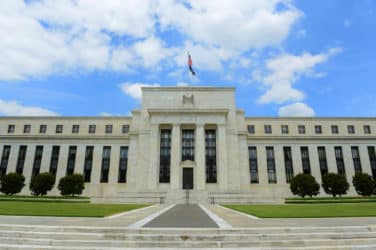Buy in May and go away?
That seems to be the prevailing sentiment on Wall Street trading desks as several traders reported thin dealings last week and expect more of the same this week. While the DJIA Industrial Index set new record highs on Thursday and pushed fresh highs on Friday, S&P 500 and NASDAQ comp are knocking on the door to new highs as well. But that failed to generate much trading activity. Stocks across the globe traded higher Thursday after Fed chair Janet Yellen struck a slightly less hawkish tone than expected, emphasizing her concerns about low inflation. During her testimony, Fed Chair Janet Yellen urged Congress to take into account the growth trajectory of the federal debt when making decisions about spending and taxation.
Also, earnings season for the second quarter began last week and will be in full swing this week – continuing to keep a lid on activity. And speaking of volume, trading last week dropped below 6 billion shares to an average of 5.91 billion shares, compared to the 6.37 billion shares the week prior, according to BATS Global Markets. Three weeks ago, volume was 7.46 billion shares per day, according to Bats.
Equities, despite the current summer malaise, can still find support as many are too afraid to sell in a flat to rising rate environment. Just Friday, Credit Suisse raised its year-end forecast for the S&P 500 and told investors to “stick with equities.” In a note the broker published, its head of global equity said “the bull market will continue” because interest rates will remain low, earnings will come in stronger than expected and the normal signs of a peak in the credit cycle are simply not there.
Quoted first on CNBC, the analyst, Andrew Garthwaite, said that perhaps the most important factor of the current bull market is a slowdown in wage growth.

Larry Peruzzi, Mischler Financial
“The critical issue is that the acceleration in U.S. wage growth that had been evident has slowed down,” he said. He went on to say the labor force is “unlikely” to command more pricing power until other, tighter labor markets like the United Kingdom or Japan experience acceleration in wage growth.
Larry Peruzzi, Managing Director International Equities at Mischler Financial reported Traders and investors returned last week from the previous holiday-shortened week on Monday with the same resolve – not to do much.
“They were not willing to outright sell and not looking to make large bets,” Peruzzi began. “As a result, U.S and global markets resumed their slow, steady and non-volatile rise to new records. The MSCI all country world index closed Thursday at an all-time high. Thursday’s June PPI data was largely in line which failed to move the markets.”
Also, adding credence to the no Fed for a while sentiment, the consumer price index, measuring what consumers pay for everything from apparel to used cars, was unchanged in June from the prior month. From a year earlier, the CPI was up 1.6 percent, the fourth month of surprising weakness. Excluding food and energy, the core prices rose 0.1 percent, compared to expectations of 0.2 percent.
Also, retail sales fell 0.2 percent in June, down for a second straight month. The back-to-back monthly decline was the first time two months in a row posted lower consecutive gains since last summer.
“Inflation seems to be contained and as much as the Fed would like to raise rates there is little evidence to support that notion right now,” Peruzzi said. “As a result, probability of a July 26th rate hike is now 0% and September 20th probability dropped to 10.1%.”
With equities mired in a summer trading range amid low volatility, traders are finding fewer and fewer trading opportunities. After digesting all of last week’s economic data, fed funds futures were reflecting odds for another rate hike this year of just 46 percent, down from 52 percent before the data.
Also on the Fed front, traders noticed that financial conditions have begun to tighten as the markets accept the Central Bank’s resolve to wind down its post-crisis stimulus efforts. The Goldman Sachs U.S. Financial Conditions Index has begun to climb, along with 10-year Treasury yields and in statements made last week, Chair Janet Yellen told the House Financial Services Committee that the well-publicized reduction of the Federal Reserve’s balance sheet “should begin relatively soon.” The balance sheet probably won’t reach pre-crisis levels until 2022, she added, signaling an orderly and gradual reduction process.
In other news, regulatory demands for initial public offerings could be contributing to companies’ reluctance to go public, suggested Securities and Exchange Commission Chairman Jay Clayton. In remarks made in NYC last week at the New York Economic Club, he said the drop in the number of publicly listed companies correspondingly limits investors’ access to investment opportunities. “The potential lasting effects of such an outcome to the economy and society are, in two words, not good,” Clayton said.
Also, 11 members of Congress filed a letter with the Securities and Exchange Commission protesting the bourse’s acquisition by China-based Chongqing Casin Enterprise Group. The SEC had extended the comment period earlier this year so as to conduct a thorough survey of public opinion. CCEG also has U.S. investors in the group. In the letter, the politicians said, “With little or no insight and transparency into government-dominated Chinese markets, the SEC will be unable to monitor the ownership structure of CCEG after approval, leaving CHX open to undue, improper, and possibly state-driven influence.”
Lastly, ETF inflows, according to State Street Global Advisors, are off to a phenomenal start this year. The firm reported that through the first six months of 2017, US-listed ETFs have amassed over $245 billion of inflows – the best start to a year in the ETF industry’s 24 years. SSGA analysts noted that equities overall have seen $172 billion in inflows this year or 50% of last year’s entire take. This is a staggering feat, they said, considering that at this juncture in 2016, equity inflows were actually negative.
This Week’s U.S. Economic Indicators of Interest:
| Monday | Empire State Mfg Index |
|
Tuesday |
Redbook Retail Sales Wholesale Trade Import/Export Prices Housing Market Index |
| Wednesday |
Housing Starts |
| Thursday | Jobless Claims
PPI Philadelphia Fed Business Survey |
|
Friday |
Leading Economic Indicators
No Data |





